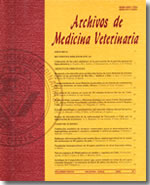Productivity of F1 Pelibuey x Blackbelly ewes and crosses with Dorper and Katahdin in a production system in the humid tropic of Tabasco, México
Main Article Content
Abstract
The aim of this study was to evaluate the reproductive performance and productivity of F1 Pelibuey x Blackbelly (P x B) ewes and their crosses with Dorper and Katahdin (Synthetic). 1612 lambing intervals (LI), 1265 prolificacy (Pr), 1263 adjusted litter weaning weights to 91 days (WWa) and1200 productivity (PROD) data were analysed. The statistical model included the fixed effects of maternal breed group (MBG), year of lambing (YL), season of lambing(SL), parity number (PN), litter size at weaning (LSW), lambing interval group (LIG) and first-order interactions. The effect of dam nested within MBG was included as random effect. The means ± SE for Pr, LI, WWa and PROD were 1.2 ± 0.01 lambs, 261.5 ± 1.9 days, 18.5 ± 0,1 kg and 16.8 ± 0,2 kg, of lamb weaned, respectively. Repeatabilities for the traits were also calculated. Except by maternal breed group, all main effects in the models were significant (P < 0.001); only season of lambing did not affect Pr. Repeatabilities were 0.05 ± 0.03, 0.13 ± 0.03, 0.10 ± 0.03 and 0.12 ± 0.03 for LI, Pr, WWa and PROD, respectively. Partial correlations of PROD with WWa and LI were 0.84 and -0.56, respectively. In conclusion, the P x B ewes had similar performance to the Synthetic group. The environmental factors have more importance than the genetics effects.

